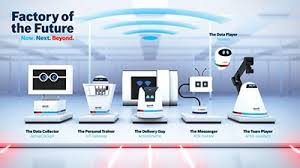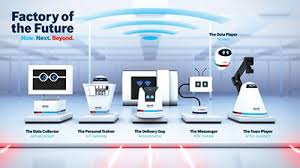Rexroth’s ambitious Factory of the Future can be stripped down for the small enterprise, step by step, easing the pain while improving the process.
June 1, 2020

Manufacturers are coming under increasing pressure to produce more product variations in the same amount of time while using the same space. Gone are the days of set-it-and-forget-it. Elements of the smart factory of the future are attainable even for the small shop. This means adopting connected manufacturing step-by-step.
|
The factory of the future includes a range of new technology modules that smaller manufacturers can add one at a time. (Image source: Rexroth) |
There are many steps along the way to the fully connected factory, but there are some key milestones that can help manufacturers see what is the appropriate first step and what steps should logically follow. Whether it’s a matter of implementing manual solutions or looking to add modular technology, it can be accomplished incrementally. Rexroth has developed a program to help smaller manufacturers implement factory-of-the-future technology.
The Early Steps to the Future
Artificial intelligence (AI) on the plant floor may sound great, but it may not be realistic for the smaller manufacturer. “The questions a small manufacturer has to ask include: Where do I start without substantial competencies, without sufficient manpower, and without a big budget? How can you make it understandable within a learning curve? How do you build up maturity to get to the factory of the future?” said Andy Hassold, connected industry consultant at Bosch Rexroth, told Design News.
According to Hassold, the answers will be different for every industry and every customer. “The beginning steps need a solid foundation. The companies that are successful – no matter size or industry – are the ones that have a lean program and a lean thinking concept,” said Hassold. “You want to have your processes defined and understood, from a materials standpoint, from equipment, and from a digital standpoint. Then you can ask” What do I do with the data? Does it just go into a repository? What will the people flow be like, the materials flow, the information flow?”
Hassold noted that manufacturers have to ask where they want to go. “What are your problems” What is your pain? Do you want AI in some areas or all areas?” said Hassold. “They should be smart about their investments.” He noted that the second step – once these questions have been answered – is technology integration. “Pick the right technology for networking, sensors, and gateways to get the right data out of your processes,” said Hassold.
Understanding Users and Data
Data is key to successful implementation. What data is necessary and who needs it? You have to ask where to store the data and how quick you need access to the data. “For data analysis you have to understand your users. Who needs the data and how frequently?” said Hassold. “Maintenance needs different data than process people do,”
To answer all of these questions, the manufacturer needs a leader to systematically approach all of the departments and then derive a first, second, and third step. “You have to prove benefits to the users on the floor using a bottom-up approach,” said Hassold. “The integration should provide solutions to pain on the floor. That will drive the adoption of the technology.”
Beyond the immediate pain, other aspects of smart technology can be added to the operation. “We can increase the scope with other AI to cover the entire breath of the supply chain, integrating the entire value chain,” said Hassold.
Where a small business – or any business – should start is with an understanding of where the operation needs to go. “What are your drivers in your business? Where do you want to set yourself apart? What pain do you have to solve so you can keep growing? Who needs the data and what are they doing with it?” said Hassold.
RELATED ARTICLES:
Rob Spiegel has covered automation and control for 19 years, 17 of them for Design News. Other topics he has covered include supply chain technology, alternative energy, and cyber security. For 10 years, he was owner and publisher of the food magazine Chile Pepper.
About the Author(s)
You May Also Like






